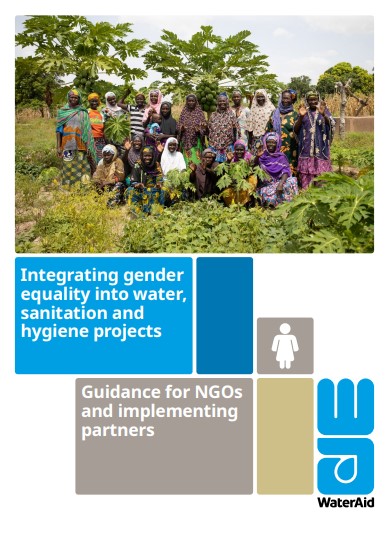Intégrer l'égalité des sexes dans les projets communautaires d'eau, d'assainissement et d'hygiène – notes d'orientation
 |
Guide pour les ONG et les partenaires de mise en oeuvre
Integrating gender equality into water, sanitation and hygiene projects
Guidance for NGOs and implementing partners
guide , manuel Aug 2022 ; 48 pages
Ed. WaterAid - London
Téléchargeable sous format: PdF
Site internet: https://washmatters.wateraid.org/sites/g/files/jkxoof256/files/integrating-gender-equality-into-water-sanitation-and-hygiene-projects---guidance-for-ngos-and-implementing-partners.pdf
Résumé:
L’eau, l’assainissement et l’hygiène (WASH) et l’égalité des sexes sont souvent traités comme des domaines thématiques distincts, même s’ils sont fondamentalement liés. Ces notes d’orientation visent à aider les entreprises, les ONG et les partenaires de mise en œuvre à transformer les engagements stratégiques en matière d’eau, d’assainissement et d’assainissement communautaires et d’égalité des sexes en projets intégrés.
Ce guide s’appuie sur l’étude innovante Ripple Effect de l’USAID, le Global Water Challenge et IPSOS dans le cadre de l’Alliance pour l’eau et le développement, avec le financement de la Fondation Coca-Cola. L’étude a fourni des preuves quantitatives et qualitatives que l’eau potable autonomise de manière unique les femmes et transforme les communautés. Abstract:
This guidance will help companies and non‑governmental organisations (NGOs) turn their organisational strategic commitments on community water, sanitation and hygiene (WASH) and gender equality into integrated projects that a) support better, more sustainable WASH outcomes and b) are critical on the pathway to women’s empowerment. It will also help implementing organisations contribute to increasing global and regional strategic commitments to gender equality including, for example, the Sustainable Development Goals (SDGs). Contents:
Chapter 1 explains why NGOs and companies should invest in, and take, an integrated approach to WASH and gender equality and women’s empowerment projects.
Chapter 2 outlines what is needed to build the foundations for gender equality and women’s empowerment into WASH projects.
Chapter 3 shares principles and approaches for our work on gender equality and women’s empowerment in WASH.
Chapter 4 demonstrates a step-by-step approach on how to embed gender equality into WASH projects through the process of project design, analysis and setting of key performance indicators (KPIs). It also signposts to relevant tools and resources to support practitioners.
Publics-Cibles:
Acteurs de coopération , Technicien , Ingénieur, concepteur , Socio-économiste , Décideurs locaux ou nationaux
Mots clefs: |
accès à l'assainissement (CI) (DT) (OP) (ope) , accès à l'eau (CI) (DT) (OP) (ope) , genre (CI) (DT) (OP) (ope) , hygiène (CI) (DT) (OP) (ope) |
Editeur/Diffuseur: |
|
WaterAid - London - Royaume Uni |
En cas de lien brisé, nous le mentionner à communication@pseau.org